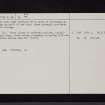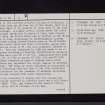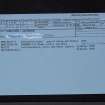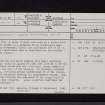Kirkconnel, Waterbeck
Village (Medieval)
Site Name Kirkconnel, Waterbeck
Classification Village (Medieval)
Alternative Name(s) Kirkconnel Lea
Canmore ID 67072
Site Number NY27NW 15
NGR NY 249 755
Datum OSGB36 - NGR
Permalink http://canmore.org.uk/site/67072
- Council Dumfries And Galloway
- Parish Kirkpatrick-fleming
- Former Region Dumfries And Galloway
- Former District Annandale And Eskdale
- Former County Dumfries-shire
NY27NW 15 249 755
See also NY27NW 16.
(NY 250 755) A large village site seen as a street with tofts and crofts in a parkland field (Kirkconnel Lea) adjoining Kirkconnel church and churchyard (NY27NE 1). (Nothing significant seen on available air photographs 106G/Scot/UK145:3199-3200 - very poor prints).
A E Truckell 1958.
Apart from the mutilated remains of a small enclosure (25.0m by 17.0m) at approx NY 2498 7551 (see NY27NW 16) only surface variations and occasional stones remain to indicate the site of the village. It probably occupied the flat, low-lying ground immediately NW of the church, the small enclosure marking its approximate centre. Rig and furrow occupies the remainder of the large field in which it was situated. Local enquiries confirmed the name 'Kirkconnel'.
Visited by OS (WDJ) 17 October 1967.
(Name: NY 249 755) Medieval Village of Kirkconnel (NR) (site of)
OS 25" map, 1971.
The site of the deserted medieval village of Kirkconnel is best viewed from the NE (the top of the field), when in a favourable light it is possible to trace much of the plan of the village. A single street, raised above the level of the slight depression in which it lies, runs roughly parallel with the Kirtle Water and is fronted on the NE by a series of long rectangular or subrectangular houses; behind these houses rig-and-furrow runs up the hillside.
SW of the street there are other structures, among them the enclosure noted by OS (WDJ), the most prominent feature on the site. This was excavated in 1968 and shown to be a pillow mound covering a structure interpreted by Laing as a Dark Age hall (see NY27NW 16). Excavations were also carried out in 1970 at approx NY 2505 7543 and NY 2510 7537. These revealed an area of cobbles and a stone drain, which may represent the slight remains of medieval structures. The range of finds indicates an occupation in the area extending from the 13th to the 16th centuries. No firm evidence for the presence of medieval buildings and roads has emerged from these excavations.
Truckell (TSA 1962) considers it likely that the village was substantially deserted in 1320-60; there was a mill there in the 1560s. Pont, who worked in the area in 1595-6, shows a mill, but no village, on his map. There is also some evidence for a group of buildings on the high ground N of the site; these probably post-date the main village.
T H McK Clough and L R Laing 1969; L R Laing and E J Talbot 1977.
NY 252 755. Three pieces of medieval pottery, spindle whorl and slag, found during ploughing in spring 1979 are in Dumfries Museum (Accession no: 79:82).
A E Truckell 1979.
Note (1997)
NY27NW 15 2498 7551
Listed with NY27NW 16 as building, fermtoun (possible) and burnt mound. Stray finds and finds from excavation include glass bead, pottery, whorls and iron artefacts
RCAHMS 1997.














